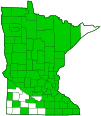bluntleaf sandwort
(Moehringia lateriflora)
Conservation • Wetland • Description • Habitat • Ecology • Use • Distribution • Taxonomy
Description |
||
Bluntleaf sandwort is a common but often overlooked perennial forb. It rises from an extensive network of slender, horizontal, underground stems (rhizomes) and fibrous roots. It often forms small colonies. It occurs in Asia, northern Europe, and North America. In the United States it is common in the northern tier of states but absent in the south. It is very common in Minnesota. The stems are slender, weak, round, and 2″ to 11¾″ long. They either curve upward from the base (ascending) or recline on the ground with just the tips ascending (decumbent). They are usually much branched, sometimes sparingly branched. They are green and moderately to densely covered with short, downward curved hairs. They do not have gland-tipped hairs. The leaves are opposite, ¼″ to 1¼″ long, and 3 ⁄16″ to ⅜″ wide, about 3 times as long as wide. They are stalkless or on short stalks (petioles) no more than 1 ⁄32″ (1.0 mm) long. Rarely, there is a cluster of smaller leaves in the leaf axil. The leaf blades are broadly elliptic to oblong-elliptic or inversely egg-shaped. They are tapered at the base and rounded to bluntly angled at the tip. The leaves are not fleshy, and the leaf base does not fuse with the base of the adjacent leaf. The upper surface is hairless with a prominent, depressed midvein and sometimes a pair of lateral veins. The lower surface is moderately hairy just along the midvein, otherwise hairless. The margins are untoothed and may be hairless of have a fringe of minute hairs. The inflorescence is is a cluster of 2 to 5 flowers at the end of the stem, single flowers at the branch tips, and sometimes single flowers from the upper and middle leaf axils. The flowers are on erect or ascending, ⅛″ to 1¼″ long stalks (pedicels). At the base of each pedicel there is a pair of 1 ⁄32″ to ⅛″ long appendages (bracts) that look like small leaves with thin white margins. The flowers are about ⅜″ in diameter. There are 5 sepals at the base of the flower, 5 petals, 10 stamens, and 3 styles. The sepals are green, egg-shaped or inversely egg-shaped, and 1 ⁄16″ to ⅛″ long, about half as long as the petals. They are rounded or bluntly angled at the tip and have thin white margins. They do not have a pronounced midrib or a bristle-like extension of the midrib (awn). The petals are white, widely spreading, and showy. They are inversely lance-shaped to narrowly inversely egg-shaped and ⅛″ to ¼″ long. They are rounded at the tip, not notched, and are tapered at the base but not to a narrow stalk-like base (claw). The stamens rise from the margins of a small nectar disk. The filaments are free, not fused together. The anthers are yellowish-white. The fruit is an almost globe-shaped, ⅛″ to 3 ⁄16″ long capsule with 2 to 6 seeds. The capsule has 6 curved teeth on the top. At maturity, the capsule splits open along the teeth, releasing the seeds. The seeds are reddish-brown, smooth, shiny, kidney-shaped, and about 1 ⁄32″ (1.0 mm) wide. Each seed has a white, spongy, elliptical appendage. |
||
Height |
||
Ascending. Stems 2″ to 11¾″ long |
||
Flower Color |
||
White |
||
Similar Species |
||
Large-leaved sandwort (Moehringia macrophylla) leaves are much longer, up to 2″ long. It has been reported only in Cook and Lake Counties. Long-leaved chickweed (Stellaria longifolia) petals are deeply cut, appearing as 10 petals. The leaves are about 5 times as long as wide. Mouse-ear chickweed (Cerastium fontanum ssp. vulgare) petals are deeply notched. |
||
Habitat |
||
Moist to moderately dry. Woodland edges and openings, open woodlands and gravely riverbanks; less commonly, meadows and prairies. Partial sun to light shade. Loamy, gravelly, or sandy soil. |
||
Ecology |
||
Flowering |
||
May through July |
||
Pests and Diseases |
||
|
||
Use |
||
|
||
Distribution |
||||
|
Sources |
|||
| 2/25/2023 | ||||
Nativity |
||||
Native |
||||
Occurrence |
||||
Very common |
||||
Taxonomy |
|||
| Kingdom | Plantae (Plants) | ||
| Division | Tracheophyta (Vascular Plants) | ||
| Subdivision | Spermatophytina (Seed Plants) | ||
| Class | Magnoliopsida (Dicots) | ||
| Subclass | Caryophyllidae | ||
Order |
Caryophyllales (Pinks, Cactuses, and Allies) | ||
Family |
Caryophyllaceae (Pink) | ||
| Subfamily | Alsinoideae | ||
| Tribe | Arenarieae (sandworts) | ||
Genus |
Moehringia (grove sandworts) | ||
Bluntleaf sandwort was formerly classified as Arenaria lateriflora. In 1962 it was transfered to the new genus Moehringia based on the number of chromosomes and on the spongy seed appendage. |
|||
Subordinate Taxa |
|||
Four varieties have been described based on the width of the leaves and hairs of the underside of the leaves. However, these varieties are not widely accepted. |
|||
Synonyms |
|||
Arenaria lateriflora Arenaria lateriflora var. angustifolia Arenaria lateriflora var. tayloriae |
|||
Common Names |
|||
blunt-leaf sandwort bluntleaf sandwort blunt-leaf grove-sandwort grove sandwort |
|||
Glossary
Ascending
Growing upward at an angle or curving upward from the base.
Awn
A stiff, bristle-like appendage at the tip of the glume, lemma, or palea of grass florets.
Axil
The upper angle where a branch, stem, leaf stalk, or vein diverges.
Bract
Modified leaf at the base of a flower stalk, flower cluster, or inflorescence.
Claw
A stalk-like narrowed base of some petals and sepals.
Decumbent
Reclining on the ground but with the tips ascending.
Filament
On plants: The thread-like stalk of a stamen which supports the anther. On Lepidoptera: One of a pair of long, thin, fleshy extensions extending from the thorax, and sometimes also from the abdomen, of a caterpillar.
Glandular hairs
Hairs spread over aerial vegetation that secrete essential oils. The oils act to protect against herbivores and pathogens or, when on a flower part, attract pollinators. The hairs have a sticky or oily feel.
Pedicel
On plants: the stalk of a single flower in a cluster of flowers. On insects: the second segment of the antennae. On Hymenoptera and Araneae: the narrow stalk connecting the thorax to the abdomen: the preferred term is petiole.
Petiole
On plants: The stalk of a leaf blade or a compound leaf that attaches it to the stem. On ants and wasps: The constricted first one or two segments of the rear part of the body.
Rhizome
A horizontal, usually underground stem. It serves as a reproductive structure, producing roots below and shoots above at the nodes.
Visitor Photos |
|||||
Share your photo of this plant. |
|||||
| This button not working for you? Simply email us at info@MinnesotaSeasons.com. Attach one or more photos and, if you like, a caption. |
|||||
|
|||||
MinnesotaSeasons.com Photos |
|||||
Plant |
|||||
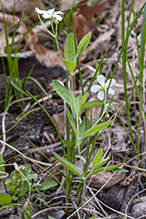 |
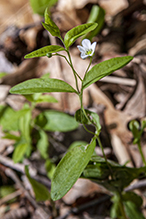 |
||||
Inflorescence |
|||||
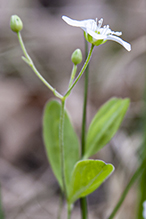 |
|||||
Flower |
|||||
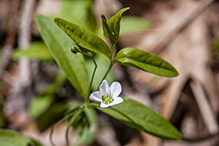 |
|||||
Leaves |
|||||
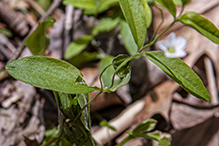 |
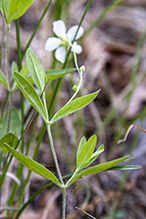 |
||||

Slideshows |
||

Visitor Videos |
|||
Share your video of this plant. |
|||
| This button not working for you? Simply email us at info@MinnesotaSeasons.com. Attach a video, a YouTube link, or a cloud storage link. |
|||
Other Videos |
|||
| Moehringia lateriflora Top # 5 Facts Harish Pandya |
|||
About
Published on Oct 29, 2015 Moehringia lateriflora Top # 5 Facts |
|||

Visitor Sightings |
|||||
Report a sighting of this plant. |
|||||
| This button not working for you? Simply email us at info@MinnesotaSeasons.com. Be sure to include a location. |
|||||
|
|||||
MinnesotaSeasons.com Sightings |
|||||

|
Created: Last Updated: © MinnesotaSeasons.com. All rights reserved. |
